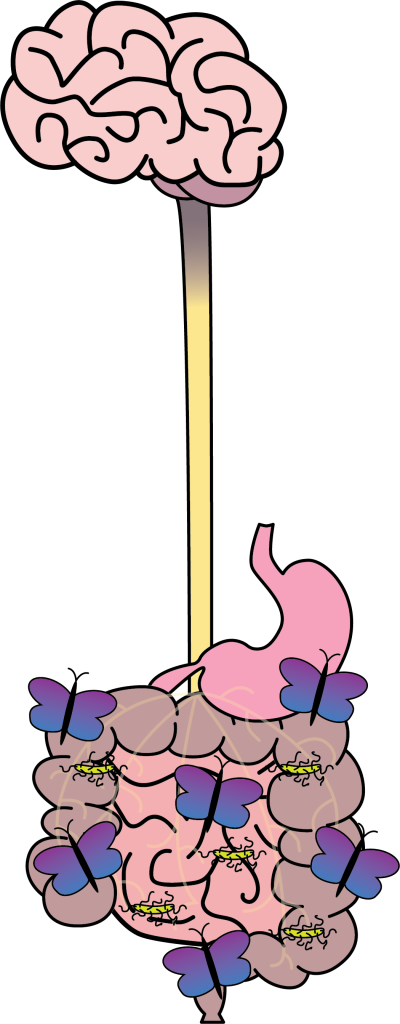
Have you ever experienced “butterflies in your stomach?” Maybe a “gut feeling” that just cannot be explained? Nerve cells can be found in even more places than the brain or the central nervous system: enter the enteric nervous system (ENS). The ENS, a unit of the peripheral nervous system, is a group of nerve cells found in the digestive tract that control digestion. It is connected to the brain – hence the gut-brain connection. These nerve cells are responsible for controlling feeding behaviors, intestinal muscle contractions, and much more.
The gut microbiome refers to bacteria that live in the gut and secrete signaling molecules such as neurotransmitters, short chain fatty acids, and amino acids that could affect the ENS.1 A growing body of research suggests that the connection between the microbiome and the brain influences the manifestation and progression of diseases such as Parkinson’s disease, gastrointestinal conditions, and mental illness.2 The earliest of such findings was the colonization of certain E. coli strains that could confer resistance to dysentery among World War I soldiers.1 In the 21st century, researchers observed that different species of microorganisms colonized different parts of the digestive tract.3 As an example, groups used ileostomy samples to observe that the small intestine, due to its high acidity, harbors more fast-growing anaerobes than the large intestine.3 Now, researchers are returning to the microbiome as a potential factor contributing to mental disorders and neurodegeneration. One day, gastroenterologists may even prescribe antidepressants for conditions such as irritable bowel syndrome because of this connection. This connection has also led to research initiatives, such as the National Institutes of Health Human Microbiome Project (2007-2016) which aimed to determine what bacteria made up the human microbiome (https://hmpdacc.org/).
There are many researchers in the Tri-I that are studying this gut-brain connection. Ilyan D. Iliev, Ph.D., at Weill Cornell Medicine, studies immunity in the mucosa, specifically focusing on fungi. A recent paper from Dr. Iliev’s lab found that fungal communities, also known as the mycobiota, are able to modify the host immune system and affect social behavior through IL17R-signaling in neurons.4 Dr. Iliev is also the co-director for the Microbiome Core at Weill Cornell Medicine which supports investigators who wish to sequence microbiological samples.
Michael Kaplitt, MD, PhD., also at Weill Cornell Medicine, is looking into how the gut-brain connection can be implicated in Parkinson’s disease. With support from The Michael J. Fox Foundation, Dr. Kaplitt’s lab studies how Parkinson’s disease could start in the gut and spread to the brain through the vagus nerve. A recent finding from the lab found that injection of α-synuclein, a presynaptic protein, into the digestive tract of mice induced aggregates that could travel along the vagus nerve. These aggregates could lead to non-motor phenotypes of Parkinson’s disease, such as depression and sleep disturbances.5 Another investigator on this grant is Dr. Roberta Marongiu, who investigates the effect of menopause on Parkinson’s disease and the gut. Women have an increased likelihood of developing Parkinson’s disease after menopause, suggesting a link between estrogen levels and non-motor phenotypes of Parkinson’s.
Across the street, Daniel Mucida, Ph.D, a Howard Hughes Medical Institute investigator at the Rockefeller University, is researching how the intestinal environment contributes to and affects immune response. A recent paper from his lab shows that the gut microbiota can activate sympathetic neurons in the ENS through heightened expression of a transcription factor called cFos, which leads to regulation of gastrointestinal movement.6 Furthermore, the authors found that bacteria expressing short-chain fatty acids led to the downregulation of cFos expression in gut sympathetic neurons.6
The Tri-I institutions have long been at the forefront of innovative research and research on the gut-brain connection includes many areas yet to be resolved. As precision medicine and other technologies become increasingly improved, researchers can hope to make discoveries broadening our understanding of how our diets and gut microbiome are linked to our brains.
Sources
- Lewandowska-Pietruszka, Z.; Figlerowicz, M.; Mazur-Melewska, K. The History of the Intestinal Microbiota and the Gut-Brain Axis. Pathogens 2022, 11 (12), 1540. https://doi.org/10.3390/pathogens11121540.
- Gwak MG, Chang SY. Gut-Brain Connection: Microbiome, Gut Barrier, and Environmental Sensors. Immune Netw. 2021;21(3):e20. Published 2021 Jun 16. doi:10.4110/in.2021.21.e20
- Donaldson, G. P.; Lee, S. M.; Mazmanian, S. K. Gut Biogeography of the Bacterial Microbiota. Nat Rev Microbiol 2016, 14 (1), 20–32. https://doi.org/10.1038/nrmicro3552.
- Leonardi, I.; Gao, I. H.; Lin, W.-Y.; Allen, M.; Li, X. V.; Fiers, W. D.; De Celie, M. B.; Putzel, G. G.; Yantiss, R. K.; Johncilla, M.; Colak, D.; Iliev, I. D. Mucosal Fungi Promote Gut Barrier Function and Social Behavior via Type 17 Immunity. Cell 2022, 185 (5), 831-846.e14. https://doi.org/10.1016/j.cell.2022.01.017.
- Dautan, D.; Paslawski, W.; Montejo, S.; Doyon, D.; Marangiu, R.; Kaplitt, M. G.; Chen, R.; Dawson, V. L.; Zhang, X.; Dawson, T. M.; Svenningsson, P. Gut-Initiated Alpha Synuclein Fibrils Drive Parkinson’s Disease Phenotypes: Temporal Mapping of Non-Motor Symptoms and REM Sleep Behavior Disorder. April 26, 2024. https://doi.org/10.1101/2024.04.22.590542.
- Muller, P. A.; Schneeberger, M.; Matheis, F.; Wang, P.; Kerner, Z.; Ilanges, A.; Pellegrino, K.; Del Mármol, J.; Castro, T. B. R.; Furuichi, M.; Perkins, M.; Han, W.; Rao, A.; Pickard, A. J.; Cross, J. R.; Honda, K.; De Araujo, I.; Mucida, D. Microbiota Modulate Sympathetic Neurons via a Gut–Brain Circuit. Nature 2020, 583 (7816), 441–446. https://doi.org/10.1038/s41586-020-2474-7.
